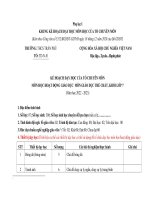a0088 oracle database 10g sql fundamentals i morebook vn 6597
Bạn đang xem bản rút gọn của tài liệu. Xem và tải ngay bản đầy đủ của tài liệu tại đây (26.89 KB, 7 trang )
Oracle Database 10g: SQL
Fundamentals II
Student Guide • Volume 1
D17111GC10
Edition 1.0
March 2004
D39192
®
Author
Copyright © 2004, Oracle. All rights reserved.
Priya Vennapusa
This documentation contains proprietary information of Oracle Corporation. It is
provided under a license agreement containing restrictions on use and disclosure and
is also protected by copyright law. Reverse engineering of the software is prohibited.
If this documentation is delivered to a U.S. Government Agency of the Department of
Defense, then it is delivered with Restricted Rights and the following legend is
applicable:
Technical Contributors
and Reviewers
Nancy Greenberg
Priya Nathan
Andrew Brannigan
Angelika Krupp
Brian Boxx
Christopher Lawless
Joel Goodman
Malika Marghadi
Marjolein Dekkers
Stefan Grenstad
Zarko Cesljas
Rosita Hanoman
Ruediger Steffan
Publisher
Joseph Fernandez
Restricted Rights Legend
Use, duplication or disclosure by the Government is subject to restrictions for
commercial computer software and shall be deemed to be Restricted Rights software
under Federal law, as set forth in subparagraph (c)(1)(ii) of DFARS 252.227-7013,
Rights in Technical Data and Computer Software (October 1988).
This material or any portion of it may not be copied in any form or by any means
without the express prior written permission of Oracle Corporation. Any other copying
is a violation of copyright law and may result in civil and/or criminal penalties.
If this documentation is delivered to a U.S. Government Agency not within the
Department of Defense, then it is delivered with “Restricted Rights,” as defined in
FAR 52.227-14, Rights in Data-General, including Alternate III (June 1987).
The information in this document is subject to change without notice. If you find any
problems in the documentation, please report them in writing to Education Products,
Oracle Corporation, 500 Oracle Parkway, Redwood Shores, CA 94065. Oracle
Corporation does not warrant that this document is error-free.
Oracle and all references to Oracle Products are trademarks or registered trademarks
of Oracle Corporation.
All other products or company names are used for identification purposes only, and
may be trademarks of their respective owners.
Preface
Preface - 2
Profile
Before You Begin This Course
•
Before you begin this course, you should have working experience with SQL.
Prerequisites
•
Oracle Database 10g: SQL Fundamentals I
How This Course Is Organized
Oracle Database 10g: SQL Fundamentals II is an instructor-led course featuring lectures and hands-on
exercises. Online demonstrations and written practice sessions reinforce the concepts and skills introduced.
Preface - 3
Summary (continued)
SGA Memory Structures
The System Global Area (SGA) has three primary structures:
• Shared pool: Stores the most recently executed SQL statements and the most recently used
data from the data dictionary
• Database buffer cache: Stores the most recently used data
• Redo log buffer: Records changes made to the database using the instance
Background Processes
A production Oracle instance includes the following processes:
• Database writer (DBW0): Writes changed data to the data files
• Log writer (LGWR): Records changes to the data files in the online redo log files
• System monitor (SMON): Checks for consistency and initiates recovery of the database
when the database is opened
• Process monitor (PMON): Cleans up the resources if one of the processes fails
• Checkpoint process (CKPT): Updates the database status information after a checkpoint
• Archiver (ARC0): Backs up the online redo log to ensure recovery after a media failure
(This process is optional, but is usually included in a production instance.)
Depending on its configuration, the instance may also include other processes.
SQL Statement Processing Steps
The steps used to process a SQL statement include:
• Parse: Compiles the SQL statement
• Execute: Identifies selected rows or applies DML changes to the data
• Fetch: Returns the rows queried by a SELECT statement
Oracle Database 10g: SQL Fundamentals II D-29









